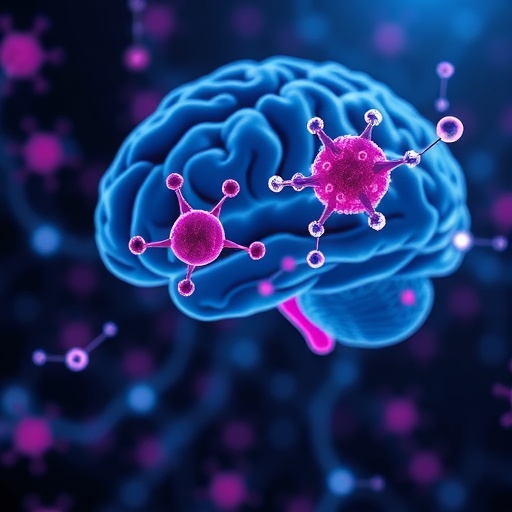In a groundbreaking advance emerging from the laboratories of Texas A&M AgriLife Research, scientists have unveiled a revolutionary avenue in neurobiology involving the use of exquisitely structured metallic nanoparticles known as nanoflowers. These nanoscale floral architectures, composed of transition metal dichalcogenides, exhibit remarkable neuroprotective properties that target mitochondrial health at a cellular level—a breakthrough that holds profound implications for the treatment of debilitating neurodegenerative disorders such as Parkinson’s and Alzheimer’s disease.
At the very core of this research lies the intricate relationship between mitochondria—the cellular organelles often dubbed the powerhouses of the cell—and neuronal viability. Mitochondria are responsible for converting nutrients into usable biochemical energy in the form of ATP, a process vital to cell survival and function. However, the energetic metabolism within mitochondria inherently generates reactive oxygen species (ROS), unstable molecules capable of inflicting oxidative damage to cellular DNA, proteins, and lipids. Such oxidative stress is a recognized contributor to the pathogenesis of multiple neurological disorders.
The investigative team at Texas A&M, led by associate professor Dmitry Kurouski, employed these transition metal dichalcogenide nanoflowers to assess their capacity to regulate mitochondrial function and oxidative stress in brain cells. Their experimental study meticulously documented how these nanostructures interact with neurons and astrocytes, the supporting glial cells responsible for maintaining neural network homeostasis. Within a short 24-hour exposure period, treated cells demonstrated a profound reduction in ROS levels and exhibited enhanced mitochondrial integrity and biogenesis, indicating both protective and restorative capacities.
Unlike conventional therapies that primarily address symptomatic relief, this nanomaterial-based strategy offers a paradigm shift by directly modulating the mitochondrial microenvironment to tackle the root causes of cellular degeneration. This fine-tuning of mitochondrial performance via nanoflowers effectively minimizes the accumulation of harmful oxidative byproducts, thereby supporting the resilience and longevity of neural cells vulnerable to chronic stress.
The allure of nanoflowers extends beyond cellular assays. The team translated their findings into a living organism model, utilizing Caenorhabditis elegans—an established nematode used extensively for neurological and lifespan research. Remarkably, nanoflower-treated worms exhibited extended lifespan metrics and decreased early-life mortality, suggesting that the cellular benefits observed in vitro potentially translate to systemic neuroprotection and overall organism health enhancement.
Pushing the boundaries of translational research, Kurouski’s group is poised to advance their work into further preclinical stages, including toxicological profiling and biodistribution analysis within mammalian models. These forthcoming investigations are critical to establishing the safety and efficacy profiles necessary for eventual clinical trial candidacy, propelling nanoflowers closer to pharmaceutical reality.
The implications of this science are vast, particularly given the current paucity of disease-modifying therapies for neurodegenerative diseases. Parkinson’s and Alzheimer’s, which affect millions worldwide, have traditionally been managed by symptomatic approaches that do little to halt or reverse mitochondrial decay and neuronal loss. The introduction of nanoflower technology could mark a decisive turning point by restoring mitochondrial function, promoting cellular repair mechanisms, and ultimately ameliorating neurological decline’s progression.
At the mechanistic level, transition metal dichalcogenide nanoflowers exhibit unique physicochemical properties that foster their bioactivity. Their flowerlike morphology significantly increases surface area, enhancing cellular uptake and catalytic activity within intracellular environments. This enhanced interaction capability may allow for direct engagement with mitochondrial components, facilitating antioxidative reactions and mitochondrial turnover processes such as mitophagy and biogenesis—all essential for maintaining mitochondrial quality control.
In addition to neurodegeneration, the research team envisions broad biomedical applications where mitochondrial dysfunction plays a critical role. These include acute neurological events like stroke and chronic injuries such as spinal cord trauma. Collaborations with the Texas A&M College of Medicine are anticipated to further explore these therapeutic potentials, expanding the impact horizon of nanoflower-based interventions.
An exciting milestone accompanying this research is the recent patent application filed by Texas A&M Innovation, securing the intellectual property rights around nanoflower-utilizing neuroprotective treatments. This development underscores both the novel potential and the commercial interest surrounding this technology, which could soon transition from benchside discovery to bedside application.
While optimistic, the researchers stress the necessity of rigorous characterization of nanoflowers’ safety profiles. Ensuring that these nanoparticles do not elicit adverse immunological responses or off-target toxicity remains paramount before clinical translation. Ongoing and future investigations into pharmacokinetics and long-term effects will shape the therapeutic protocols and delivery mechanisms for optimal benefit.
Ultimately, this pioneering study situates nanoflowers as a promising new class of neurotherapeutics that move beyond symptom suppression to address neurodegeneration’s fundamental biochemical disruptions. With their capability to enhance mitochondrial health, reduce oxidative damage, and improve neuronal survival, nanoflowers signify a potential paradigm shift in treating some of the most challenging neurological diseases of our time. The future of brain health, it seems, may indeed be blossoming at the nanoscale.
Subject of Research: Cells
Article Title: Neuroprotective properties of transition metal dichalcogenide nanoflowers alleviate acute and chronic neurological conditions linked to mitochondrial dysfunction
News Publication Date: 9-Apr-2025
Web References:
- Texas A&M AgriLife Research: https://agriliferesearch.tamu.edu/
- Journal of Biological Chemistry Article: https://www.jbc.org/article/S0021-9258(25)00347-3/pdf
- Texas A&M Innovation: https://innovation.tamus.edu/
- Texas A&M College of Medicine: https://medicine.tamu.edu/index.html
References: DOI 10.1016/j.jbc.2025.108498
Keywords: Mitochondria, Cell biology, Cellular physiology, Neuroprotection, Nanoparticles, Oxidative stress, Neurodegeneration, Parkinson’s disease, Alzheimer’s disease, Transition metal dichalcogenides




